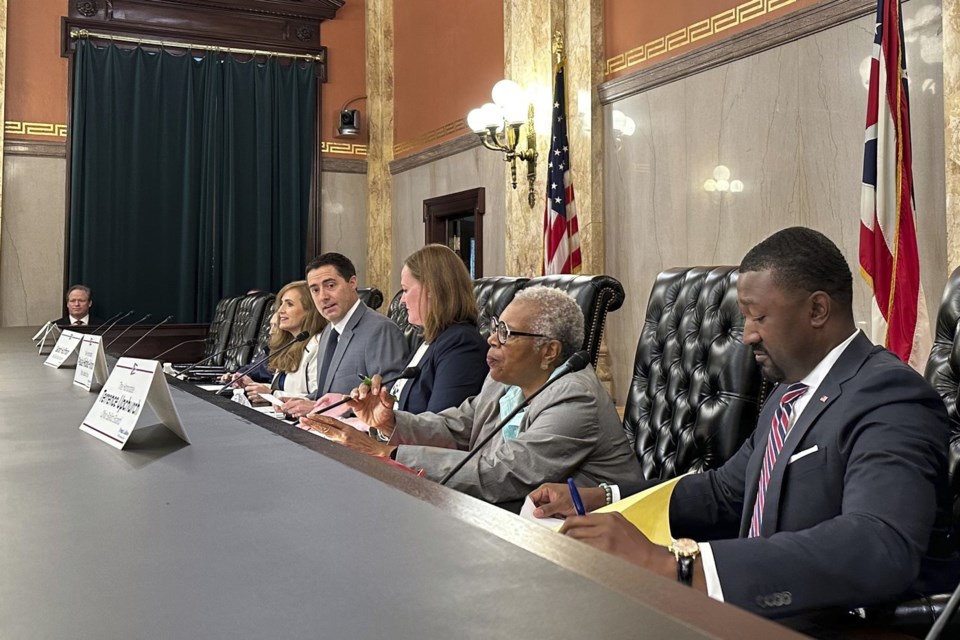COLUMBUS, Ohio (AP) — The Ohio Supreme Court should step in on behalf of voters and order a rewrite of ballot language for a that “may be the most biased, inaccurate, deceptive, and unconstitutional" the state has ever seen, argues a lawsuit filed late Monday.
Citizens Not Politicians, the campaign advancing November's Issue 1, and two individuals brought the against the Ohio Ballot Board and Republican Secretary of State Frank LaRose, the state's elections chief and the panel's chair.
“This Court’s intervention is needed to ensure that Ohio voters are provided with the truthful and impartial ballot title and ballot language required by law so that they can exercise their right to determine for themselves whether to amend the Ohio Constitution,” the lawsuit says.
The proposed amendment, advanced by a , calls for replacing the state's troubled existing political map-making system, which produced seven sets of Statehouse and congressional maps that were declared unconstitutionally gerrymandered to favor Ohio's ruling Republicans. It would replace the existing redistricting commission — made up of four lawmakers, the governor, the auditor and the secretary of state — with a 15-person citizen-led commission of Republicans, Democrats and independents. Members would be selected by retired judges.
At issue in this case is ballot language the ballot board approved Friday along party lines. Among other things, it would describe the proposed constitutional amendment, which seeks to “ban partisan gerrymandering,” as creating a 15-member Citizens Redistricting Commission that would be “required to gerrymander” Ohio’s legislative and congressional districts.
Republican state Sen. Theresa Gavarone, who moved to add that particular phrasing, said the context met the Oxford English Dictionary definition of “gerrymander.”
In its lawsuit, Citizens Not Politicians said the approved ballot language “gets it entirely backward,” since their proposal bans partisan manipulation of the maps. “It does so by ensuring that the plans adopted by the Commission seek to approximate the statewide partisan preferences of Ohioans while drawing geographically contiguous districts that reflect communities of interest,” the lawsuit says,
Redistricting is the process of dividing a state into new districts for conducting elections, typically to reflect updated population figures from the decennial U.S. Census. Gerrymandering is defined as: "to manipulate the boundaries of an electoral constituency so as to favor one party or class.”
The litigation alleges the gerrymandering language and numerous other phrases contained in the 900-word ballot description violate provisions of the Ohio Constitution that require ballot language to properly identify what is being proposed and prohibit wording that may “mislead, deceive, or defraud the voters.”
Other than the change advanced by Gavarone, it was developed by LaRose and his staff in what he has described as a painstaking process aimed at accuracy and fairness.
The lawsuit calls it “an absolute fusillade of falsehoods.” It contends that the wording misdescribes the partisan affiliation requirements of commission members, inaccurately suggests the amendment would limit Ohioans' rights to “freely express their public opinions,” and falsely states that it would prohibit “any citizen” from filing a lawsuit against the plan “in any court.”
“Every single paragraph of the ballot language includes misleading and biased language that further serves to sway voters against the Amendment,” it states.
The ballot board under LaRose has faced several recent lawsuits against its ballot language, alleging the wording was misleading or defective.
Last August, the Republican-majority court approved to describe a constitutional amendment guaranteeing access to abortion and other forms of reproductive care — though it let stand much of the challenged phrasing. During an unsuccessful U.S. Senate run last year, LaRose revealed that he had while drafting the language.
In June 2023, the panel to reword its description of a constitutional amendment that would have made amending Ohio’s constitution harder.
Both LaRose and Gavarone left Friday's ballot board without speaking to reporters. Instead, they recorded a 35-minute podcast with Republican Ohio Senate President Matt Huffman's communications chief, John Fortney, defending the ballot board's actions and blasting the fall proposal — which they have dubbed “Political Outcomes Over People.” — as undemocratic, overbroad and unwieldy.
Amid legal clashes, Ohio’s 2022 elections went forward under unconstitutional maps.
That year, Republicans won 10 of Ohio’s 15 congressional seats under the unconstitutional U.S. House map, though Democrats . The disputed Statehouse maps yielded Republican supermajorities.
LaRose pointed to those election results during the podcast as evidence Ohio’s system is working.
“Listen, when the voters of Ohio have created a supermajority of Republicans in the House and a supermajority of Republicans in the Senate, and they’ve given every statewide office to Republicans, I think they’re telling us something,” LaRose said on the show. “I think they’re telling us they prefer conservative public policy and they prefer us to operate in that manner.”
Julie Carr Smyth, The Associated Press




